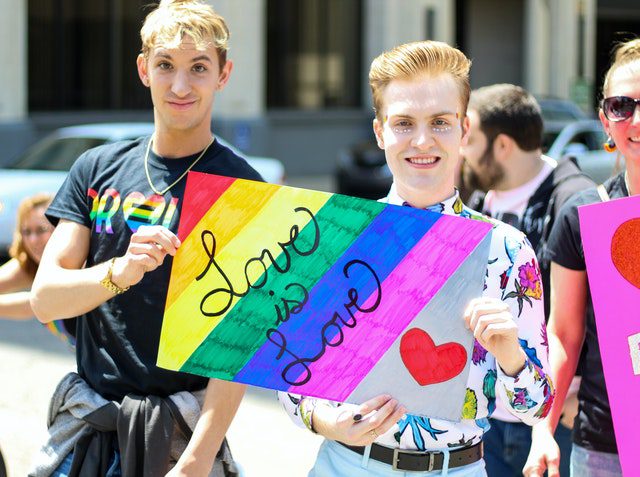
Difference Between Sexual Orientation and Gender Identity
When you look at the acronym LGBT – LGB stands for sexual orientations such as lesbian, gay, bisexual. The T relates to gender identity (transgender, although there is recognition that there are many gender identities, which makes transgender an umbrella term). So, for example, we can speak about a trans woman who was assigned male at birth but has transitioned to adopt social norms that are more feminine. More often than not, people socially transition before they undergo physical transitions.
Sexual orientation suggests that people can be attracted to more than one gender, regardless of whether they are a transgender person or not. So, for example, the most common sexual orientation that most people are familiar with is an orientation where individuals are attracted to people of the same sex as them. Gender identity is why we need to be sensitive about gender pronouns. LGBT+ individuals can also fall anywhere under the gender identity umbrella as lesbian, gay, and bisexual people can also identify with different gender identities.
Many transgender people undergo physical transitions so that their gender identity can be expressed physically. Usually, people socially transition first and then explore further roots to transition.
Gender Expression
Gender expression is vital to most transgender people. The range of gender expressions is endless and depends entirely on the individual’s imagination. Your gender expression is how you choose to show the world what your gender identity is. It is the best way to celebrate gender diversity and is all about how individuals perceive themselves and how they would like to be perceived by the rest of society.
We moved away from the gender binary approach of ‘men and women’ as these are primarily cultural expectations based on physical characteristics typically present at birth or associated with secondary sex characteristics typically developing during puberty. These days gender is more about your internal knowledge about yourself, and we understand that multiple genders exist.
Social support is crucial for the purpose of gender expression. If you are unsure how to begin supporting LGBT+ people, an excellent place to start is to adopt gender-neutral pronouns when you are unsure of someone’s preferred pronouns.

Sexual Orientation: A Closer Look
This refers to traits that a person is attracted to in others. It is inherent and is not a choice. It is furthermore broken down into sexual attraction and romantic orientation.
Sexual orientation is separate from gender identity. Remember, this means that trans people can identify with any specific sexual orientation or romantic orientation, as there is no prerequisite specific sexual orientation prescribed to trans people.
Orientations have not been classified as mental disorders for quite some time. However, the initial classification of homosexuality as a mental illness sparked many of the LGBTQ+ community’s involvement with mental health care providers.
When the two communities work together, they have the power to spread awareness far and wide. However, remember that transgender is an umbrella term, and in order to break the term down according to a specific individual, you will need some internal knowledge about that individual.
Sexual orientation is complicated, and there are many different variations with which people identify. For example, some people are attracted to the same gender (lesbian/gay people) as their own. Others are drawn to only one different gender, while others are still attracted to many different genders, including their own.
It is important to remember that because gender identity is different from sexual orientation, a person can belong to any imaginable combination of gender identity and sexual orientation. For example, a gender nonconforming individual can identify as pansexual. Or cisgender assigned female can identify as asexual. The combinations are endless, and the diversity is amazing.
Sexual orientation can also be fluid and does not need to be static. Some people can move between gender identities and sexual orientations alike.
Sexually Attracted
Sexual attraction is sometimes separate from romantic attraction, and the two can differ substantially. Sexual attraction refers specifically to what we find sexually arousing in another person and not necessarily what we are looking for in romantic relationships.
For example, asexual people will not experience sexual attraction, but they might experience romantic attraction and romantic desire. Even if in a romantic relationship, they might engage in sexual acts despite a lack of sexual attraction simply because they enjoy the other person’s company and want to make them happy or to experience the closeness that sex can bring.

Romantically Attracted
Romantic desire likely has nothing to do with sex and sexuality. Although it is part of the sexual orientation of an individual, it refers more to what an individual finds romantically attractive in another person. It is often a little bit more abstract than sexual attraction but is no less critical.
It is evident that sexual orientation and gender identity are complex concepts and cannot be simply quantified.
Some people will go on to separate romantic attraction from emotional attraction as well. Regardless though, it is crystal clear that sexual orientation and gender identity are both rich and diverse.
Overview of the History of Gender Orientation

Gender Identity Disorder
The diagnosis of Gender Identity Disorder speaks of the history of gender identity that is rooted in the sphere of mental illness. Not that long ago, in the Diagnostic and Statistical Manual (DSM) IV, gender identity incongruence was classified as a mental disorder. However, with the introduction of the Diagnostic and Statistical Manual (DSM) 5, Gender Identity Disorder no longer exists as one’s gender identity cannot be viewed as a mental illness.
Although cases like this (the misclassification of one’s gender identity perception as a mental disorder) cause significant problems for transgender people, it can be noted that two good things tend to come of such blunders. Firstly, backlash from the community spreads awareness. The appropriate response at correction by the medical and psychiatric communities lends power to the LGBTQ community and cement that their insight is valuable and should be respected accordingly.
Any further alliances formed between sexual minorities and mental health professionals are extremely valuable and create solid foundations for building better mental health care that caters to diversity. For example, suppose mental health professionals can better understand the depth and reach of gender identity. In that case, they are better equipped to help people with gender dysphoria to self-actualize and become the best possible versions of themselves.
The way that gender dysphoria is classified today indicates that the only treatment is gender transition, and treatments no longer aim at changing a person’s mind to match their physical sex.
Gender Dysphoria
Although gender dysphoria is still in the DSM and is still diagnosable, we need to understand one crucial difference. It is not classified under mental disorders. It is more akin to a state of distress that can be treated with gender expression measures or gender transition, such as social changes or gender affirmation treatments. The goal is no longer to ‘cure’ gender identity issues by getting individuals to conform to socially defined behaviors, as was the case in the past. Instead, the focus is on harmonizing the body with how the individuals perceive their gender identity within themselves. It is a practice that now celebrates human diversity and human sexuality and no longer requires adherence to socially defined behaviors.
Gender dysphoria is often connected to the appearance and social connotation of the external genitalia and what is associated with biological sex, including primary and secondary sex characteristics.

Gender Identity
Gender identity refers to how an individual identifies with their own gender. This can be anywhere on the spectrum between cisgender males and cisgender females.
A person’s sexual identity or gender identity does not need to have anything to do with the sex assigned at birth. In fact, many people do not feel well-aligned with their sex assigned at birth at all, and some go on to undergo physical transitions to address this dysphoria with their sex assigned at birth.
An umbrella term that is used to describe many gender identity-related issues is ‘transgender’. This refers to any situation where one’s gender identity differs from social and cultural expectations based on biological sex.




